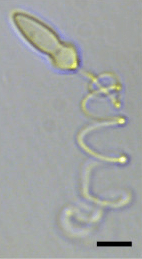Polykrikaceae
The Polykrikaceae (also known as Polykrikidae) are a family of athecate dinoflagellates of the order Gymnodiniales. Members of the family are known as polykrikoids. The family contains two genera: Polykrikos and Pheopolykrikos.[2]
| Polykrikaceae | |
|---|---|
 | |
| A light micrograph of Polykrikos kofoidii showing an extruded nematocyst. Scale bar = 10µm.[1] | |
| Scientific classification | |
| (unranked): | SAR |
| (unranked): | |
| Phylum: | |
| Class: | |
| Order: | |
| Family: | Polykrikaceae |
| Genera | |
| |
Characteristics
The most distinctive feature of polykrikoids is their formation of multinucleate "pseudocolonies" consisting of an even number of subunit zooids. The two genera differ in number of nuclei; possessing two nuclei regardless of the number of zooids is a synapomorphy for Polykrikos, whereas Pheopolykrikos possess equal numbers of nuclei and zooids.[3]
Along with the Warnowiaceae (warnowiids), polykrikoids are known for possessing unusually complex subcellular structures. In particular, an extrusome complex of two organelles called the nematocyst and taeniocyst is considered a synapomorphy for Polykrikos.[1][3] Molecular phylogenetics studies suggest some inconsistency in the taxonomy of this group, particularly in the assignment of species to one of the two genera.[4][5]
Habitat and life cycle
Most polykrikoids are planktonic, although one species - P. lebourae - is benthic.[3] The family includes photosynthetic, heterotrophic, and mixotrophic species.[6] Some species, such as P. kofoidii, are of scientific interest due to their status as predators of other dinoflagellates, a behavior that is significant in the regulation of algal blooms.[6][7][8] Others, such as Ph. hartmanii (which has been reclassified P. hartmanii)[5] are themselves causes of ichthyotoxic algal blooms.[9]
The reproductive behaviors of polykrikoids are mostly not well understood, although P. kofoidii has been studied and found to have a complex life cycle of both vegetative (asexual) and sexual reproduction complicated by its pseudocolonial structure.[10]
Evolution
The family demonstrates a complex evolutionary history indicating multiple instances of loss of photosynthetic plastids in different lineages.[6] The distinctive pseudocolonial structure may have arisen in multiple evolutionary lineages from ancestors capable of forming chains of distinct individual cells.[3]
References
- Hoppenrath, M; Bachvaroff, TR; Handy, SM; Delwiche, CF; Leander, BS (25 May 2009). "Molecular phylogeny of ocelloid-bearing dinoflagellates (Warnowiaceae) as inferred from SSU and LSU rDNA sequences". BMC Evolutionary Biology. 9: 116. doi:10.1186/1471-2148-9-116. PMC 2694157. PMID 19467154.
- Michael D. Guiry (2015). Guiry MD, Guiry GM (eds.). "Polykrikaceae Kofoid & Swezy, 1921". AlgaeBase. National University of Ireland, Galway. World Register of Marine Species. Retrieved 8 August 2015.
- Hoppenrath, Mona; Leander, Brian S. (April 2007). "Character Evolution in Polykrikoid Dinoflagellates". Journal of Phycology. 43 (2): 366–377. doi:10.1111/j.1529-8817.2007.00319.x.
- Reñé, Albert; Camp, Jordi; Garcés, Esther (May 2015). "Diversity and Phylogeny of Gymnodiniales (Dinophyceae) from the NW Mediterranean Sea Revealed by a Morphological and Molecular Approach". Protist. 166 (2): 234–263. doi:10.1016/j.protis.2015.03.001. PMID 25847865.
- Hoppenrath, Mona; Yubuki, Naoji; Bachvaroff, Tsvetan R.; Leander, Brian S. (January 2010). "Re-classification of Pheopolykrikos hartmannii as Polykrikos (Dinophyceae) based partly on the ultrastructure of complex extrusomes". European Journal of Protistology. 46 (1): 29–37. doi:10.1016/j.ejop.2009.08.003. PMID 19767184.
- Gavelis, Gregory S.; White, Richard A.; Suttle, Curtis A.; Keeling, Patrick J.; Leander, Brian S. (17 July 2015). "Single-cell transcriptomics using spliced leader PCR: Evidence for multiple losses of photosynthesis in polykrikoid dinoflagellates". BMC Genomics. 16 (1): 528. doi:10.1186/s12864-015-1636-8. PMC 4504456. PMID 26183220.
- Matsuyama, Y; Miyamoto, M; Kotani, Y (1999). "Grazing impacts of the heterotrophic dinoflagellate Polykrikos kofoidii on a bloom of Gymnodinium catenatum" (PDF). Aquatic Microbial Ecology. 17: 91–98. doi:10.3354/ame017091.
- JEONG, HAE JIN; KIM, SOO KYEONG; KIM, JAE SEONG; KIM, SEONG TAEK; YOO, YEONG DU; YOON, JOO YIH (May 2001). "Growth and Grazing Rates of the Heterotrophic Dinoflagellate Polykrikos kofoidii on Red-Tide and Toxic Dinoflagellates". The Journal of Eukaryotic Microbiology. 48 (3): 298–308. doi:10.1111/j.1550-7408.2001.tb00318.x. PMID 11411838.
- Tang, Ying Zhong; Harke, Matthew J.; Gobler, Christopher J.; Cock, M. (December 2013). "Morphology, phylogeny, dynamics, and ichthyotoxicity of (Dinophyceae) isolates and blooms from New York, USA". Journal of Phycology. 49 (6): 1084–1094. doi:10.1111/jpy.12114.
- Tillmann, Urban; Hoppenrath, Mona (April 2013). "Life Cycle of the pseudocolonial dinoflagellate (Gymnodiniales, Dinoflagellata)". Journal of Phycology. 49 (2): 298–317. doi:10.1111/jpy.12037.